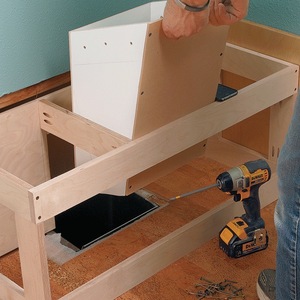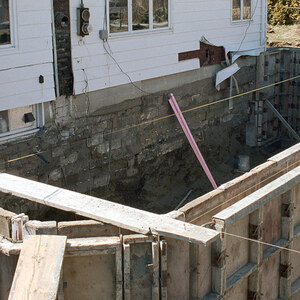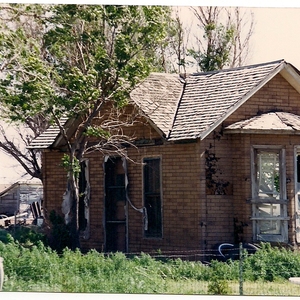Hi All,
I’m a regular poster over at The Fence and CT, just hopping over here with a question on a ventillation problem I’m having. Be kind, since my knowledge of construction and construction terms is pretty limited! 🙂
This past summer, DH built a a free standing 2-stall shed unit for our horses. I’ve attached a pic. The eaves, both front and back, have thin (1″ to 2″ wide) ventillation strips and the shed itself is certainly not airtight. There are some cracks in the walls along the top. Now, I know that drafts are different from proper ventillation, but I just wanted to point out that there is some airflow.
The siding is Texture-111 (sic) and then there’s plywood (I think it’s 3/8″ thick) plywood for walls on the inside–only up to about 8 feet high.
The ceiling on the inside is developing a fairly even coating of mold. 🙁 I don’t think the roof is leaking, as it’s a pretty even coating and I can’t believe the whole roof would be leaking. I also have not noticed any drips of water during rain or snow melt.
I’m concerned about this, as horses can develop lung/breathing problems similar to asthma if they’re stalled in barns with improper ventillation. So, I’m looking for suggestions as to what I can do to improve the ventillation. Hopefully, something that I can manage myself, as DH seems to relinquished all maintenance to me. :-0 He has a pretty good set of tools and I should be able to figure out how to use them without sawing off my hands or fingers!
I should be able to get some pics if you’ld like to see the shed or anything.
Thanks!
AnnL
Transitions Farm
Gardening, cooking, and riding Central Mass.


















Replies
I have a couple of half baked thoughts.
BTW, your attachment did not make it up. Try again in a reply post and be sure to wait for the upload to finish.
Anyway, in a house, we usually want one foot of ventialtion for every 150 feet of living space, when insulated. With horses in a close space generating a lot of steam form sweat, breathing, and urine, I would expect to quadruple that at least, and since you probably have no insulation, double that fuigure again.
Another thing to help is to get the horses out for a dauy, and scrub down the mildew or whatever with a chlorine mixed 10% ( Unless horses are likely to react with residue) and then spray things down with borates. Cherapest version of that is Borax soap, but there are gel products for mixing ( Boracare is one) available to prevent mold growth. Finally, you can paiont with oil paint and an added mildewcide.
Boron is a natural element and is totally nontoxic to mammals but is deadly to molds, fungii, and many insects.
Welcome to the
Taunton University of Knowledge FHB Campus at Breaktime.
where ...
Excellence is its own reward!
My best guess is that he built it too tight. With open ground and horses, there is a lot of moisture in that building. Moisture is going to go up with the heat and condense on the cold roof where it molds. It might not condense to the point of dripping, but it's definitely imparting enough moisture to sustain mold growth.
Do you have a ridge vent to compliment the soffit vents? One easy solution would be to put in mechanical ventalition near the ridge. If you don't electricity, you will need to cut in a passive ridge vent (if you don't have one).
MERC.
Piffin and DJ -- Thanks for responding. I've uploaded some pics. First one shows the shed. BTW is a 12'x24' structure. There's no ridge, so no ridge vent. The next two pics show the vents in the front and back eaves (or soffits??). I am considering trying to remove the vents and the wood around the vents to open up the eaves and get circulation in there that way. But, would that make it too drafty in there?? I could then put some sort of screening up in the spring to try to keep bees out.
The last pic shows the inside, front wall of one of the stalls. Can't really see it in the pic, but along the bottom edge of the horizontal board, to the left of the hanging apple, there is a gap of about 1/2" wide and several inches long. There are a couple of those gaps along the front wall in both stalls. Also, in the corners of the unit, where those metal poles (which are the frame) extend through the texture111, there is about an inch of space around the metal. I was originally intending to use foam insulation to close up all these "drafts" but then when I noticed condensation on the windows, I decided to keep the drafts in the hope it would help ventilation. The sliding doors are also not very tigh and snow has blown into the stalls through the doors. So, it doesn't seem to be "tight".
Someone suggested that I put in a wall vent down low on one of the walls. Would that help or make it too drafty?
The horses are outside for 10-12 hours a day, depending on the weather, so once I get the ventillation fixed I should be able to get rid of the mold. I'll have to check to see if the chlorine will be a problem, but I think it will be OK. The biggest concern would be the fumes, but at 10% I don't think I need to worry, especially if the ventillation is fixed! :-)AnnLTransitions FarmGardening, cooking, and riding Central Mass.
Ann,Little backgrouns.......grew up on a farm (grain and livestock) and on horseback. Not near enough ventilation for the winter. At the very least I would replace the entire plywood soffit area (front and back) with ventilation material. This may not prove to be sufficient either.In the winter, hypothetically the ground/floor in there will be cold enough for their copius amounts of urine to freeze in "relatively" short order. The colder, the faster.......of course. In warmer temps that freezing will slow dramatically and the entire time the vapor rises, it condenses in the air and against the underside of the roof. Best to keep cleaned up under them to minimize this generation of vapor when temperatures allow.And these animals give off large volumes of water vapor just from breathing. That too will condense out on any surface cold enough and/or in the air itself. Folks tend to forget that these are animals well-suited to the rigors of nature. Wrapping them up in a tight building is neither necessary nor good for their health. Not unless that buidling is temperature and humidity controlled. And then they won't be conditioned to spend any length of time outside. Many horses spend the entire winter outside with nothing but a smallish three-sided building to get out of the snow and cold/freezing rain. They fare well under these circumstances. Much better off health-wise than if they are being couped up too tightly. Only if temps fall into dangerously cold ranges would couping them up close likley be more beneficial than detrimental.Our horses were housed in the "big barn". 40' to the peak. No humidity issues to speak of even though there was also considerable other livestock in there. Adequate ventilation was maintained. Consider the cattle barns you see around. They all have one complete side open. The reason is because they too will develop respiratory problems if confined in a too-tight building.Edit: When I said cattle barn, I meant beef cattle. Dairy cattle are usually a different matter. Many/most spend their entire winter inside, but their collective body heat keeps the barn quite warm, is supplemented with a unit heater if needs be and the manure is removed a couple times a day...........at least. Knowledge is power, but only if applied in a timely fashion.
Edited 1/12/2005 10:24 pm ET by GOLDHILLER
Hi Goldhiller,
Thanks for your response. I envy your childhood--that's what I grew up dreaming about!
My horses are out pretty much all day--they go out about 6:00 am most mornings and then come in when it's getting dark, which is about 5:00 pm. Yesterday, we had a snow/ice storm and they wanted to come in about 3:30, but I left one of their doors open until I closed them up at 9:00. I have thought about leaving one door open over night (I have stall guards up which would keep them in), but we have a problem with rabies up here--2 dogs in the neighboring town were attacked by skunks in 2 seperate incidents last week. So, I worry about something getting in there with them. :-(
The stalls are cleaned every morning. The stall floors are matted, which probably doesn't help the issue does it--the urine can't soak down into the ground.
My ideal situation would be to keep the horses in in/out stalls, so they could come and go as they please. But, my big guy is a bit of a bully to the filly, so I don't trust him not to trap her in one of the stalls and kick the crap out of her! The ultimate plan is to convert the garage to a barn and then this shed unit will become the 3-sided run-in shed that you mentioned. That's a much larger building (24'x36') so the ventilation shouldn't be a problem in there. And, it does have a ridge, so a ridge vent will be on the list of to-dos!
I will open up the soffits and see if that does the trick. If not, do you have any other suggestions?
AnnLTransitions FarmGardening, cooking, and riding Central Mass.
Ann:
I don't know a thing about horses, but I do live in NJ horse country (hunterdon county) and I can tell you that most of the barns I see around me that hold horses have power ventilation either on the roof or the gable end. Most of them are also much bigger and taller than your shed. I would guess you just have too much horse for the building and that you'll need a power vent of some sort to really fix the issue.
J Painter
ann, The more I think on this, the more I wonder if there isn't a better method to achieve ventilation for your shed and to have it adjustable to boot. Using the readily available perforated vent materials aren't going to serve you best IMO..even though I suggested that myself last night. Consider once that this material is not "all vent" and it's screened which isn't necessary and can cause problems with the venting when those screens clog with airborne dust,etc. Screens aren't going to do a thing for you to keep out wasps and such because....well....this is a barn and the barn door (and windows) is left open in the warmer months when these insects are active. In the colder months, bugs just aren't around. How's about this? On the back soffit of the building, pull the existing soffit material and replace it with a wood frame(s) containing hardware cloth. 1/4" or so. Or just simply cut a swath (maybe 4"- 8") out of the existing ply and cloth over that) This approach would provide for more/better ventilation intake and the HC will perhaps serve to deter bats and birds to some degree.Yes, under the worst of winter storms, you could get a bit of wind driven snow finding it's way up under there. Shouldn't amount to all that much and you could always provide for some manner of closure for severe snow storms.
On the front, you could do the same strip removal and HC over. Or you could get fancier on this "exhaust" side by giving yourself some control of just how much ventilation takes place by creating long narrow (4"- 8" to match intake size) hinged doors under there that you could open or close to varying requirements. These doors would run the entire width of the building. Maybe even create two parallel runs of these for better control; one fixed and one adjustable. I think perhaps a better way to do the exhaust venting on this type of building might well be to design and engineer venting into the fascia on the front with a top-hinged fascia. Might still be able to do this by slipping a long strip of rubber up under your drip edge to accommodate the various angles it would be set at in order to regulate flow and still shed water off that hinged edge. Venting this way would probably be a bit more effective per sq inch of opening because you aren't asking the air to take as much of a downward path to exit as you are with a vented exhaust soffit on this style of roof. http://www.gov.on.ca/OMAFRA/english/engineer/facts/96-031.htmAlso.... Googling "horse barn ventilation" returns many hits.Knowledge is power, but only if applied in a timely fashion.
Edited 1/13/2005 10:14 am ET by GOLDHILLER
"I envy your childhood--that's what I grew up
dreaming about!"Ya know....when I was a kid and teenager, I envied the town kids. Played baseball and basketball all day or laid around watching the tube. Wrestling livestock, cleaning up under them, riding tractors in the blazing sun and dust, makin' hay and grinding feed didn't hold much allure. No girls out there, netiher. They were all in town somewhere commiserating with those guys. <G>It wasn't until my mid-twenties that I finally realized how good I had it as a youngster and how beneficial all that was to character development, a good self-motivated work ethic and self-reliance. Priceless, really. You won't find too many whiners out here. PS - The horse-ridin' part I always liked. :-)Knowledge is power, but only if applied in a timely fashion.
Edited 1/13/2005 11:57 am ET by GOLDHILLER
You won't find too many whiners out here.
Certainly not! Animals don't care about your problems, they just need to be fed and exercised on schedule. :-) I started riding as an adult in my late 20s and even at that ripe old age I learned about work ethic and self-discipline. It made me realize how I wasted my school years. The kids that work at the barns I've boarded at over the years are developing that work ethic, no sleeping until noon when they've got to get to the barn to feed and turnout, no hanging around at the malls when you've got a horse show to get ready for, etc. Their parents support them in it because it's keeping them (mostly girls) away from the boys! ;-)
Thanks to everyone for the input! I probably won't be able to do too much now in the middle of winter, but I have lots to plan for spring projects!
AnnLTransitions FarmGardening, cooking, and riding Central Mass.
Well, you have more severe weather in central Mass than we do in Calif, but I suspect that you need to get way better air circulation under the roof.
People exhale about a quart of moisture during the night and I'm sure that horses exhale quite a bit more. Their body heat will carry the moisture up and cause the mildew problems. (It's the same thing that happens in a bathroom)
If you have a ridged roof, put in a ridge vent or some "eyebrows" near the top of the ridge. If it's a shed roof, create (or widen) the openings on the highest side.